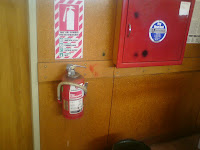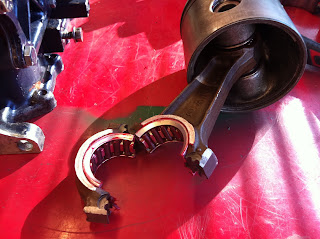Thursday, March 31, 2011
Safety - Machine Shop
Machine Shop – Safety
Safety Gear
Safety Boots (steel cap boots) - these can be made from leather and MUST have a steel cap toe these will protect your toes from getting injured and prevent heavy objects from falling an injuring your foot.
Safety goggles- Safety goggles basically come in two types of models: plastic and moulded rubberized models. They must be worn when drilling metal using lathe and any other machine which will injure the eyes
Overalls – these can be made from cotton or any other flame resistance material. Overalls must be worn when working in the workshop they must be off the right size. Make sure that you are comfortable in the overall that it is not too big or small but just the right size.
Gloves, Ear muffs, Apron etc
above student wearing full safety gear. overalls, steel cap boots and safety glasses
Types of fire extinguisher
Water Fire Extinguishers:
The cheapest and most widely used fire extinguishers. Used for Class A fires. Not suitable for Class B (Liquid) fires, or where electricity is involved.
The cheapest and most widely used fire extinguishers. Used for Class A fires. Not suitable for Class B (Liquid) fires, or where electricity is involved.
Fire Extinguisher there are
Class A: | SOLIDS such as paper, wood, plastic etc |
Class B: | FLAMMABLE LIQUIDS such as paraffin, petrol, oil etc |
Class C: | FLAMMABLE GASES such as propane, butane, methane etc |
Class D: | METALS such as aluminium, magnesium, titanium etc |
Class E: | Fires involving ELECTRICAL APPARATUS |
Water Fire Extinguishers:
The cheapest and most widely used fire extinguishers. Used for Class A fires. Not suitable for Class B (Liquid) fires, or where electricity is involved.
The cheapest and most widely used fire extinguishers. Used for Class A fires. Not suitable for Class B (Liquid) fires, or where electricity is involved.
Foam Fire Extinguishers:
Used for Classes A & B fires. Foam spray extinguishers are not recommended for fires involving electricity, but are safer than water if accidentally sprayed onto live electrical apparatus.
Used for Classes A & B fires. Foam spray extinguishers are not recommended for fires involving electricity, but are safer than water if accidentally sprayed onto live electrical apparatus.
Dry Powder Fire Extinguishers (commonly used)
often termed the ‘multi-purpose’ extinguisher, as it can be used on classes A, B & C fires. Best for running liquid fires (Class B). Will efficiently extinguish Class C gas fires, BUT BEWARE, IT CAN BE DANGEROUS TO EXTINGUISH A GAS FIRE WITHOUT FIRST ISOLATING THE GAS SUPPLY. Special powders are available for class D metal fires.
often termed the ‘multi-purpose’ extinguisher, as it can be used on classes A, B & C fires. Best for running liquid fires (Class B). Will efficiently extinguish Class C gas fires, BUT BEWARE, IT CAN BE DANGEROUS TO EXTINGUISH A GAS FIRE WITHOUT FIRST ISOLATING THE GAS SUPPLY. Special powders are available for class D metal fires.
For Metal Fires: A specialist fire extinguisher for use on Class D fires - metal fires such as sodium, lithium, manganese and aluminium when in the form of swarf or turnings.
Foam Fire Extinguishers:
Used for Classes A & B fires. Foam spray extinguishers are not recommended for fires involving electricity, but are safer than water if accidentally sprayed onto live electrical apparatus.
Used for Classes A & B fires. Foam spray extinguishers are not recommended for fires involving electricity, but are safer than water if accidentally sprayed onto live electrical apparatus.
Dry Powder Fire Extinguishers (commonly used)
often termed the ‘multi-purpose’ extinguisher, as it can be used on classes A, B & C fires. Best for running liquid fires (Class B). Will efficiently extinguish Class C gas fires, BUT BEWARE, IT CAN BE DANGEROUS TO EXTINGUISH A GAS FIRE WITHOUT FIRST SEPARATING THE GAS SUPPLY. Special powders are available for class D metal fires.
often termed the ‘multi-purpose’ extinguisher, as it can be used on classes A, B & C fires. Best for running liquid fires (Class B). Will efficiently extinguish Class C gas fires, BUT BEWARE, IT CAN BE DANGEROUS TO EXTINGUISH A GAS FIRE WITHOUT FIRST SEPARATING THE GAS SUPPLY. Special powders are available for class D metal fires.
For Metal Fires: A specialist fire extinguisher for use on Class D fires
Some off the safety procedures off the lathe is shown below and these are very important and must be followed as we were shown by our instructor.
Few important things are fold all loose clothing, tie all long hair and remove all loose jewellery.
Wear right safety glasses.
Make sure that the lathe that the buttons within easy reach of the operator.
Centre punch work deeply enough to provide support for the piece while it is turning
Remove chuck wrench immediately after adjusting chuck.
Adjust tool and tool rest so that they are slightly above the centre of the work..
Remove all tools, measuring instruments and other objects from saddle or lathe bed before starting machine.
Stop lathe before taking measurements of any kind.
Keep floor around lathe clean and free of oil and grease to prevent any acc claims.
Bench Drill
Wear appropriate safety glasses.
Adjust the table height to which is required for the job you are doing.
Ensure that the drill press has a start/stop button within easy reach of the operator.
Use a dust pan to remove cuttings.
Remove burrs and chips from a drilled hole. When making deep holes, clean out the hole frequently.
Use a clamp to prevent work from spinning. This must be done to prevent any kind off injury to your self and others.
Oil drill bit when drilling metal.
Keep floor around the drill press free of oil and grease.
Keep guards in place and in good working order.
I don’t know much about the milling machine as I only used it a few times but below are some off the safety producers that should be taken. It’s in the simplest form.
Wear appropriate safety glasses.
Ensure that the work piece and cutter are mounted securely before taking a cut.
Check that work is mounted squarely.
Hold milling cutters with a cloth to avoid being cut when handling them.
Move table as far as possible from cutter while setting up work to avoid injuring your hands.
Mill the largest surface first.
Keep hands, brushes and rags away from the revolving milling cutter.
Know the purpose of each tool in your toolbox, and use each for the task it was designed to do.
Never use any tool--hand or power--unless you are trained to do so.
Inspect tools before each use and replace or repair if worn or damaged.
Clean tools after every use.
Keep cutting edges sharp.
Select the right size tool for the job--don't use cheaters.
Carry tools correctly-never put sharp or pointed tools in your pockets.
When hand-carrying tools, point cutting edges away from you, toward the ground.
Lightly oil metal tools and store in clean, dry place to prevent rust.
Wear Personal Protective Equipment , such as safety goggles, face shields, gloves, steel toe boots and overalls to prevent any injury.
these are some off the basic safety in the machine shop, which i have learnt so far, and some of the info which i got from the net.
references:
http://www.osh.dol.govt.nz/
http://electron.mit.edu/~gsteele/mirrors/www.nmis.org/EducationTraining/machineshop/safety.html
http://machinist.org/army-machine-tool/general-machine-shop-safety/
Friday, March 25, 2011
Tuesday, March 22, 2011
Metals - History Off Stainless Steel
History of stainless steel
It was said that the discovery off stainless steel happened between 1900-1915. Harry Brearly discovered stainless steel alloy in 1912 while seeking a corrosion resistant for gun barrels. He accidently discovered that adding chrome to low carbon steel gives it a stain resistance. It was announced two years later in the New York Times article
The first stainless steel was melted on august 13th 1913 which contained 0.24% carbon and 12.8%of chromium and nikkel alloy. The basic composition off stainless steel is iron (Fe) and chrome (Cr) this is the simplest form off stainless steel.
After the Second World War the new grades of stainless steel were much better weight to strength. These are for better corrosion resistance and strength to the one developed in the early 1920s. The future off stainless steel is becoming more widely used today from house hold items such an knives, pots an pans to medical and general use.
just a basic timeline off stainless steel below
| |||||||||||||||||||||||||||||||
The 316 type off stainless steel also called marine grade or molybdenum-alloyed stainless steel. It if the most preferred grade off stainless steel for sea water
References
http://en.wikipedia.org/wiki/Stainless_steel
the video below shows how stainless steel is made form start so enjoy.









































